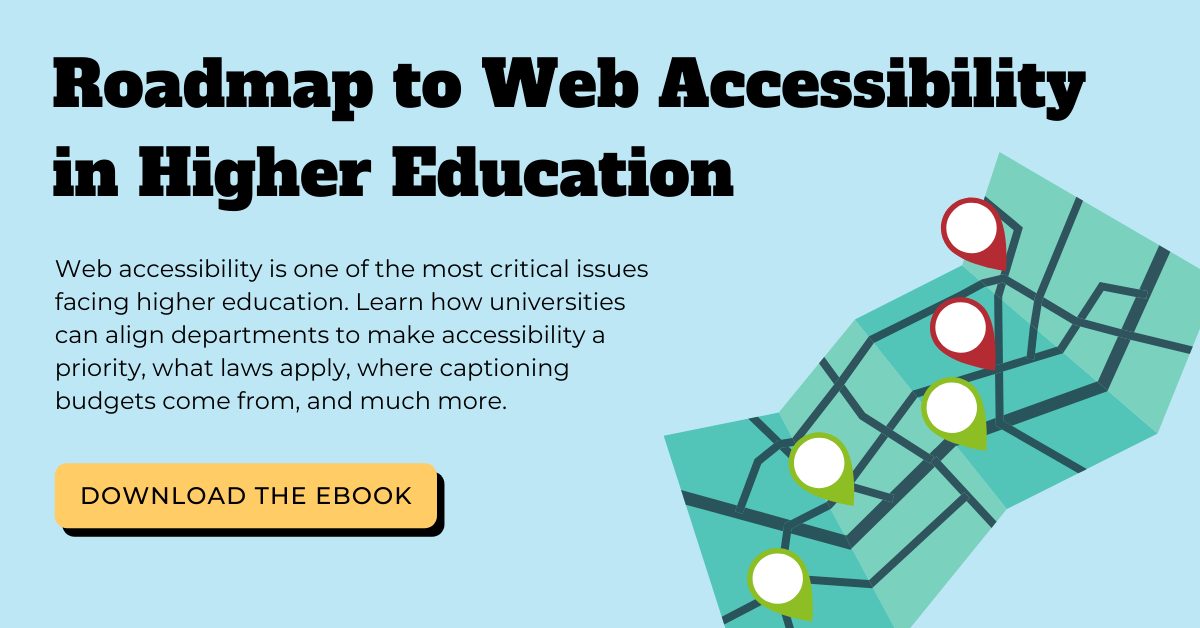Reading Settlements Helps Improve Accessibility Compliance at Your School
Updated: March 12, 2021
Educational institutions in the United States are subject to accessibility laws such as the Americans with Disabilities Act (ADA) and the Rehabilitation Act. Schools often work tirelessly to improve accessibility compliance and mitigate the risk of getting hit with a lawsuit for violations.
Adhering to all legal accessibility requirements is no small task, and schools may wonder if they’re missing anything.
While the goal is to avoid lawsuits, the legal literature stemming from rulings and settlements often provides valuable insight and direction regarding accessibility compliance. Scouring past accessibility lawsuits and settlements at other educational institutions can help indicate to schools whether or not they are doing accessibility right.
How Reading Settlements Helps Improve Accessibility Compliance
From “Dear Colleague” letters to post-trial documents, there are many resources available for schools that want to ensure they’re getting accessibility right in the eyes of the government.
Documents stemming from accessibility lawsuits at other institutions can reveal, in great detail, what the Department of Justice (DOJ) or Office for Civil Rights (OCR) considers proper accessibility implementation and adherence to federal accessibility law.
University of Washington’s Accessibility Priorities
At the University of Washington, paying attention to the results of accessibility lawsuits helps inform their accessibility policy framework. Sheryl Burgstahler and Terrill Thompson, who work in Disability Resources at the University of Washington, share with 3Play Media the lessons learned from reading DOJ and OCR resolutions at other institutions:
- Conduct an IT audit, develop a corrective action strategy, and address the problems identified.
- Set institutional standards relating to accessible technology and create a method to monitor compliance.
- Provide training and education to anyone involved with creating or procuring IT or creating content.
- Institute procedures for addressing accessibility as a requirement within the procurement process.
- Provide and publicize a mechanism by which students, faculty, staff, and members of the public can report access barriers.
Conducting a Technology Audit
The first step to improve accessibility compliance is to conduct a full internal accessibility audit or inventory of technology. Audits are an effective way to identify access barriers you would otherwise run into later.
You don’t have to be an expert to make your technologies accessible to users with disabilities. There are many free website accessibility tools and resources to guide you through an accessibility audit.
Setting Standards at Your Institution
In 2016, the DOJ sent a letter to UC Berkeley about complaints related to inaccessible tech on campus. The letter explains that while UC Berkeley has an excellent accessibility policy, they received complaints because they were failing to monitor and enforce it properly.
Setting detailed institutional standards (perhaps in the form of a web page, physical handbook, or both) is crucial to making sure that all faculty and staff know what they need to to ensure the technology they procure, use, and share is in full compliance with the school’s accessibility policy. These standards should also be accompanied by best practices and guidelines that explain how to make IT accessible for students with disabilities.
When schools disseminate required standards, there are much weaker excuses for failure to comply with the institution’s accessibility policy.
How to Implement Accessibility at Educational Institutions
Web accessibility is one of the most critical issues facing higher education. When creating an accessible infrastructure, many questions abound. This free white paper will help you get started.
Educate Those Who Procure IT and Create Content
Awareness and education are vital things that will improve accessibility compliance and initiatives at your institution. Schools can’t expect professors, administrators, and other involved parties to follow accessibility guidelines if they don’t know anything about their role in compliance.
Simply sending out an email containing your accessibility policy and guidelines titled “Read This” is helpful but may not be impactful on its own. Training videos, webinars, in-person seminars, and other engaging, interactive methods will work best because they encourage people to focus on the importance of the subject and showcase accessibility as a top priority.
Address Accessibility in the Procurement Process
Today, food labeled “organic” is in nearly every grocery store because consumers began demanding it. The same thing is happening with accessibility – people want and expect that technologies provide equal access.
Many vendors that sell to the higher education market are building accessibility into their own companies and products because universities are asking for it more and more. However, it’s still important to vet your vendors with a close eye towards accessibility since schools may be held accountable for third-party accessibility.
Ensure that you formally require your procurement decision-makers to evaluate products for accessibility compliance before making a purchase. This step could take the form of an official contract that both parties have to sign, running each purchase by a compliance officer, or a combination of both.
Make Reporting Issues Easy
It may seem counter-intuitive initially, but your school needs to have a straightforward and readily available method for reporting accessibility issues to the IT or disability services department.
Why? Because it’s better to try and resolve the issue with your department before someone considers filing a complaint with the government. Addressing inquiries and concerns head-on shows that you value community feedback and care enough to correct your accessibility shortcomings.
Put posters all over campus, send out emails, run a constant social media campaign — do whatever is necessary to funnel complaints to the right people so that your institution can resolve the issue quickly.
No school wants to face an accessibility lawsuit. Working proactively and diligently to provide accessible technologies is a critical step toward mitigating the risk. The silver lining from past accessibility-related settlements and rulings is that those in the education industry can look at them closely and learn from them.
To learn more about how to improve accessibility compliance and policies by referencing past lawsuit settlements and rulings, listen to the full webinar from the University of Washington.
This post was originally published in January 2017 by Patrick Loftus and has since been updated for clarity, freshness, and comprehensiveness.
DISCLAIMER: This blog post is written for educational and general information purposes only, and does not constitute specific legal advice. This blog should not be used as a substitute for competent legal advice from a licensed professional attorney in your state.






